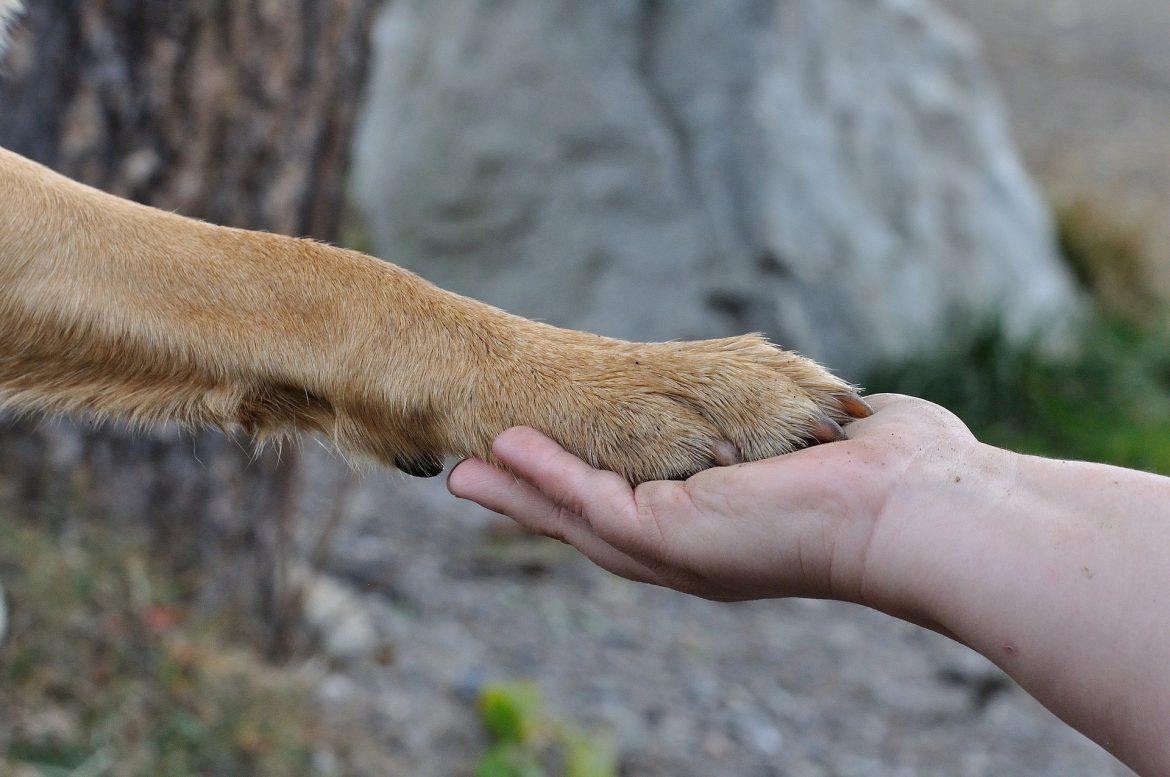“How do I train my dog to shake hands?” It’s one of the most common questions we receive. Along with the basic commands like sit and stay, this is one of those classics tricks that every dog should know. With these simple steps, though, your dog will be shaking hands like a pro!

How do I train my dog to shake hands? Here’s the basic technique
There are a few different ways to teach this fun trick. But this is the one that we’ve found is quickest:
- Start by having your dog sit down
- With a treat in your closed fist, place your hand close to your pup’s paw, a few centimetres off the floor.
- At first, your dog will likely follow their nose to the treat, and give you a quizzical look. Don’t respond and keep that treat firmly in your palm.
- Out of curiosity, your dog will eventually raise their paw to see if they can pat that treat out of your palm. As soon as your dog does this, say “shake” and give your pup the treat. Make sure to celebrate, here! This is the first step to teaching your dog how to shake hands. And, your enthusiasm will let them know they’ve done the right thing.
- Start again from step one, but make sure to raise your hand further from the floor each time. Remember not to reward or respond to your pup when they give you a snout nudge. Instead, only give them the command and reward when they place their paw on your hand.
- Once your pup has made the connection between command and action, you can try without the treat and with your palm face up. When you say “shake,” they should know what to do! If not, keep on trying from step one until they get it!
How do I train my dog to shake hands without treats?
If you’re not wild about the idea of giving your pup multiple treats, you can absolutely teach this trick without them. Try out the following alternatives to treat-based training:
- Make sure that you and your dog have a strong bond. Treats or not, your positive relationship with your pup is central to them being able to learn from you! In general, spend as much time as possible playing, cuddling, grooming, and exercising your pooch. In return, they’ll be glad to listen when you teach them to shake!
- Use plenty of verbal reinforcement. Many professional trainers find that verbal praise is just as effective as treats! This is especially true for dogs who are not particularly food-motivated, or who love attention (i.e. most puppers!)
- Try swapping out the treats for their favourite toy. Using a toy in place of a treat is a simple alternative. If the toy is too large to fit in your fist, then you can hold it behind your back until your dog has accomplished the task. Of course, in order for this to work, your dog will need to be very good at the sit and stay commands. It won’t be very effective if your pupper can’t help but to lunge for the toy before they’ve accomplished the task.
- Incorporate training at meal times. Meal times are a wonderful opportunity to sneak in some training exercises. Not only is your dog engaged and focused at this time, but they’ll also receive the best reward of the day: a full meal! Of course, you’ll only be able to give this particular reward once per session. As a result, it will take a few extra days for your dog to learn this trick. But if you think of every meal as a potential training session, asking yourself, “How do I train my dog to shake hands” will be just the beginning!
If your dog isn’t too excited about meal time, it might be that they’re not loving their dog food brand. After switching to Mad Paws Dinner Bowl, Dog Owners have shared with us that their pups are more enthusiastic about dinner time than ever!.
- Try clicker training. Another highly popular training method with professional trainers, clicker training is effective and can lower your reliance on treats. That said, treats are used at first so that your pup learns to associate the clicker sound with rewards. Over time, though, they’ll respond to the clicker itself. Clickers are great reinforcement tools no matter which of the above training methods you rely on, because they give your dog a clear signal of correct behaviour!
My dog is just not getting it, what am I doing wrong?
Don’t give up! Every dog has a different learning speed and style, and you may just need to shake things up for them to get the hang of it. Here are a few factors that might be getting in the way:
- Your dog’s breed. Every dog is trainable, even the breeds with a reputation for being stubborn (we’re looking at you, Scottish Terriers!). The trick is to find the training method that works for your individual pup. You may have to repeat the steps more times with some breeds, or use different kinds of treats to keep the attention of others. But accepting that your dog’s breed may not get it as quickly as a Border Collie may help you stick with it!
- Their energy levels. If you try to teach your pupper how to shake hands right before their daily walkie, you may be setting yourself up for failure! Instead, it’s always best to train your dog when they’ve had the chance to run off some energy. You don’t want them to be exhausted, but fitting in a quick training session after they’ve just returned home from an outing with their fun Dog Walker will give you great results!
- The setting. Can you imagine how difficult it would be to learn a new language while sitting in a crowded bar? That’s how your pup may feel if you’re trying to train them in a setting with too many distractions. For the best results, train your dog to shake hands in a quiet, neutral setting.
Are you ready to teach your dog how to shake hands?
With these simple steps and troubleshooting tips, your dog will be shaking hands in no time. You might even find other Dog Owners asking you, “How do I train my dog to shake hands like yours?”

